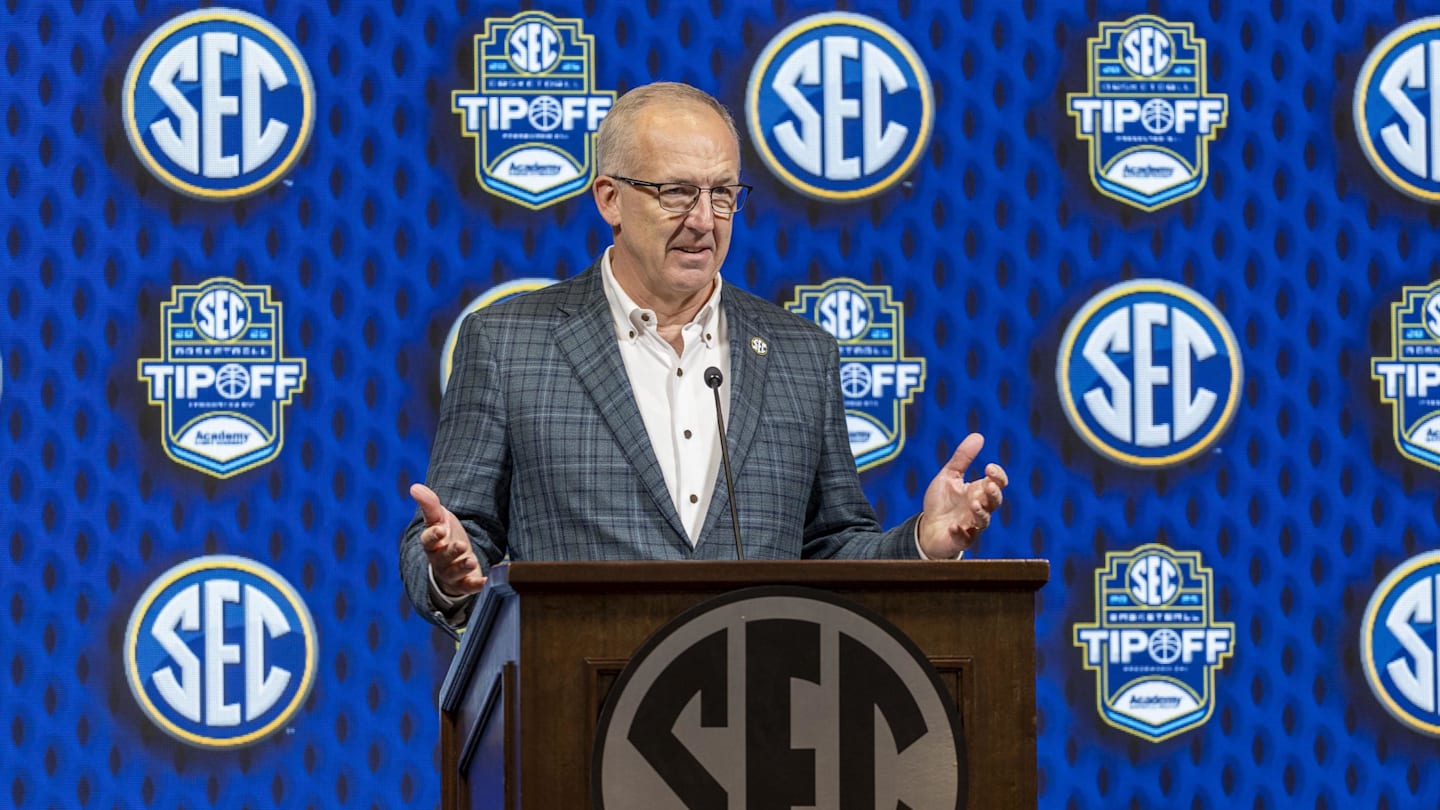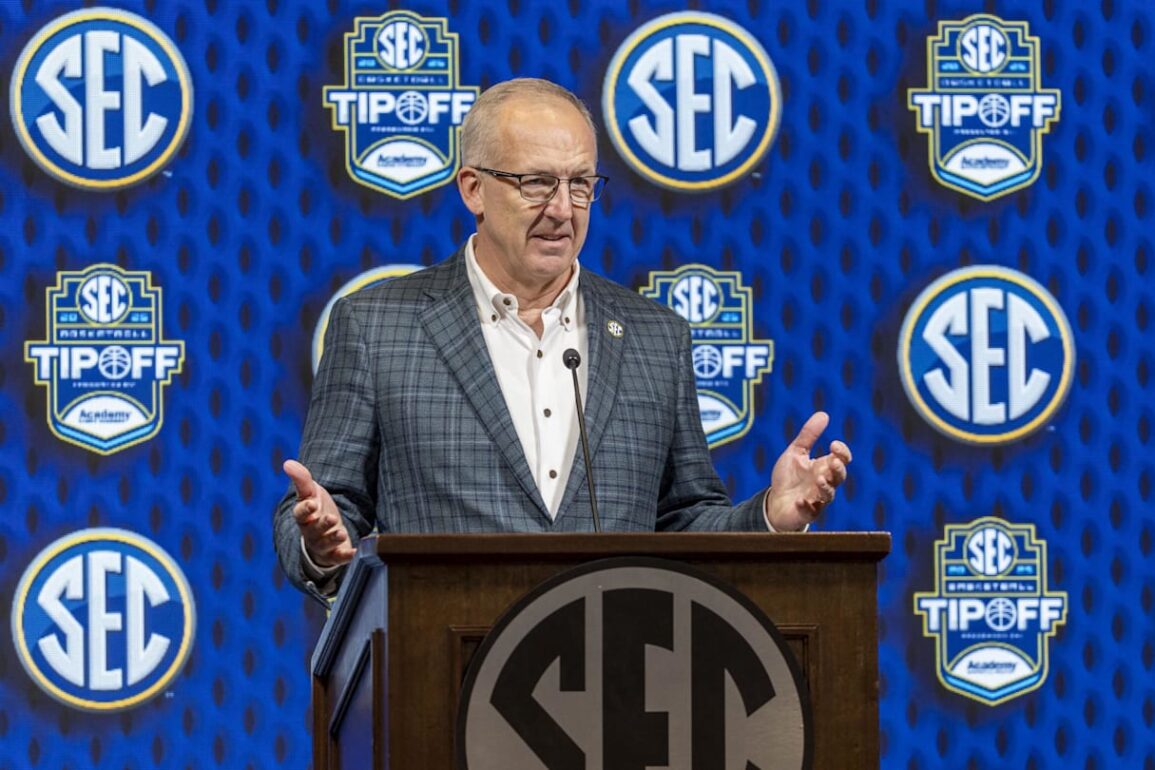
Just after Memorial Day, SEC administrators, coaches, school presidents and a handful of others will gather for the conference’s annual spring meetings in Florida.
Sometimes, these meetings include making serious decisions about the future of the league. Instead of making news next week, it appears the SEC largely finds itself beholden to it happening elsewhere first.
In a perfect world for commissioner Greg Sankey, the gathering would have been placed perfectly on the calendar to speed run a loaded docket of looming decisions. The House v. NCAA settlement would have been finalized and not delayed. The College Football Playoff format would have been decided and set in stone for this season and beyond. Those questions about when the transfer portal might take place and how the football calendar will get tweaked would have been asked and answered weeks ago.
Alas, that is not the case at all.
On nearly every front, the potential for proactive meetings and getting some business done has been somewhat damped to something far more reactive to the growing purgatory college athletics is in at the moment.
Of all the topics on the agenda, the one where there could be a modicum of progress is the one which has been brought up time and again: the potential move to nine conference games in league play.
The talk about moving away from the current eight-game schedule has been discussed in detail for the past several spring meetings and picked up a sense of urgency since the conference expanded by adding the Texas Longhorns and Oklahoma Sooners in the summer of 2021. Sankey has been a proponent and pushed hard for the change behind the scenes, and ex-Alabama Crimson Tide coach Nick Saban passionately supported the move going back almost a decade.
Yet progress has been lacking. The conference office assembled a format two years ago for nine games featuring three annual opponents and a rotating group of six more teams. Schools would naturally alternate between five and four home games every other season. The permanent opponents could be reevaluated every couple of seasons so schools without three natural rivalries could change their other locked-in series to a different school for competitive equity.
Hovering over the move to nine games is something the SEC has partial control over and must deal with: the CFP format for 2026 and beyond. Though there will be continued dialogue over a move to straight seeding for the 2025 season, the Power 4 conference commissioners gathered twice in person on the East Coast this month to chat about the longer-term future of the playoff and what it might look like. Thorny issues about the potential for multiple automatic qualifiers remain ripe for further debate though there appears to be a growing consensus, according to sources, around moving to a 16-team field as part of the new contract that begins next year.
Nothing has been set in stone just yet, which makes any potential vote on moving to nine conference games a bit trickier for the SEC. It’s a game of collegiate chicken or the egg, with millions of dollars riding on the delicate balance of weighing postseason access with the need to add another conference game.
The limited 12-team sample size of last season’s CFP, in which the Crimson Tide, Ole Miss Rebels and South Carolina Gamecocks all missed the tournament with an extra loss compared to other at-large teams, didn’t help matters and hovers in the back of the minds of many of the athletic directors tasked with navigating the future schedule. That’s one reason why the subject of having multiple automatic bids to help alleviate some of the inherent losses that would come from a nine-game slate is picking up steam.
Though the Big Ten has pushed the hardest for having three (or more) automatic qualifiers to the playoff, it appears the SEC in general is coming around to the idea more than it did at the beginning of the year. That stance is expected to be solidified in Destin, Fla., among the league and is notable considering the CFP meets again in mid-June with an unofficial deadline of making progress on a final format.
If there’s anything that could tip the SEC into moving forward with the interrelated concept of nine conference games and a corresponding push for automatic qualifiers to the CFP, it might be as simple as the bottom line.
As first reported by The Athletic, and confirmed by a source to Sports Illustrated, ESPN has given an indication to the conference that it has softened its stance on increasing the rights fees paid to the league with a move to adding a ninth conference game. Previously, the broadcaster had drawn a line in the sand on the subject, with the need for cost containment easily backed up by the string of other leagues they moved on from in recent years balanced by the massive outlays made to keep the NFL, NBA and, yes, the SEC still in the fold.
Though the current contracts do not have a specific amount the SEC would garner from the move to nine games—everything is a negotiation—there’s a growing belief it could be worth several million for each of the 16 schools (enough to likely make up for the loss of a home game every other season, at least). When factoring in increased CFP shares also set to start next year, most in the conference likely will see an uptick that comes close to, or exceeds, the $20.5 million revenue-sharing figure that is part of the House settlement which every school is budgeting for moving forward.
It helps that there’s also data to back up the case for expanding the conference slate. Last year was the first with the additions of Texas and Oklahoma along with ESPN controlling all of the conference’s football inventory. That included the marquee SEC game of the week (formerly held by CBS for a traditional 3:30 p.m. ET kickoff) on top of the added number of games that came with conference expansion.
It’s probably safe to assume that for whatever high expectations ESPN might have had coming into the 2024 season, how things played out greatly exceeded them. Controlling all the rights often meant having an SEC triple-header broadcast over the air on ABC—noon ET, 3:30 p.m. ET and prime time—that led to massive ratings on nearly every Saturday. That’s not even getting into having the uplift from additional windows on other networks. Of the 20 highest-rated college football games of the regular season last year, half were SEC conference games and five more featured at least one program from the league.
In a world where ESPN has launched a flagship direct-to-consumer product like the one coming this fall, adding another SEC-vs.-SEC matchup is understandable from a business perspective as much as it is from a competitive one in matching the Big Ten and Big 12 in playing the same number of conference games.
“It’s time,” says one SEC athletic director on the move to nine-games. “I feel like there’s a pretty good consensus now.”
We’ve heard that before. We’ve come close before.
Next week could be a little different though. It will be a delicate dance in Destin of weighing the future with the present, and the College Football Playoff with the need to play one more SEC game.
More College Football on Sports Illustrated
This post was originally published on this site be sure to check out more of their content.








